Applications of metal –organic framework composites in CO2capture and conversion
2021-05-14JieweiLiuChunyingChenKunZhngLiZhng
Jiewei Liu,Chunying Chen,Kun Zhng,Li Zhng,*
a School of Biotechnology and Health Sciences, Wuyi University, Jiangmen 529020, China
b International Healthcare Innovation Institute (Jiangmen), Jiangmen 529040, China
c School of Chemistry, Sun Yat-sen University, Guangzhou 510275, China
d School of Chemical Engineering and Light Industry, Guangdong University of Technology, Guangzhou 510006, China
ABSTRACT Reliable technologies for CO2capture and conversion(C3)are of vital importance for the establishment of a sustainable society.Metal-organic framework (MOF) composites have shown their compelling potentials for C3 due to the plentiful reticular chemistry of MOF structures and the synergistic catalysis between MOFs and the functional guests.This review focuses on the syntheses and catalytic applications towards C3 of MOF composites, which is divided into three sections.The first section gives a brief introduction about synthetic strategies of MOF composites.The second section discusses the recent progress of MOF composites in C3, including CO2chemical fixation, hydrogenation, photoreduction,electroreduction and photoelectroreduction.The third section summarizes the challenges and future prospects of MOF composites for C3.We hope that this review cannot only provide an inspiration for the rational design of MOF composites for C3, but also stimulate more and more research works in this emerging area.
Keywords:Metal-organic framework composites CO2chemical fixation CO2hydrogenation CO2photoreduction CO2electroreduction CO2photoelectroreduction
1.Introduction
The burning of fossil fuels contributes to a major CO2emission to our planet.The anthropogenic CO2discharge outpaces the natural carbon cycle in natural environment, leading to current global climate changes and adverse impact on humankinds.To establish a sustainable society, reliable technologies for CO2capture and conversion (C3) are certainly important and imperative 1–6].CO2can be converted into valuable chemicals through chemical fixation [7], hydrogenation [8], photocatalysis [9],electrocatalysis [10] and photoelectrocatalysis [11].However, the efficient CO2conversion is hampered by the high chemical stability of the C¼O bond (bond enthalpy, 805 kJ/mol), which requires a high energy input for bond cleavage [12].Therefore, efficient catalysts that can capture and activate the inert CO2molecules are highly desirable.
Various kinds of porous materials have been investigated for the C3, including ionic liquids (ILs), zeolites, porous carbons,porous organic polymers,covalent organic frameworks(COFs)and metal –organic frameworks (MOFs).Among them, MOFs are promising candidates for C3 application due to their high porosity,surface areas, structural diversity and functional adjustability 13–16].
The plentiful reticular chemistry of MOF structures offers opportunities for the rational design of MOF composites [17,18].
Firstly,the cavities of MOFs can be used for CO2adsorption.In addition, a range of functional materials such as homogeneous catalysts, semiconductors, metal nanoparticles (MNPs) and quantum dots (QDs), which are beneficial for CO2activation, can be immobilized into MOFs,giving rise to MOF composites.Moreover,the definite and uniform structures of MOFs will benefit the study of the interactions between CO2and frameworks at a molecular level.Last but not the least, synergistic effect between MOFs and the functional materials can effectively improve the catalytic performances of MOFs composites.With the integration of MOF and functional materials, the MOF composites combine their merits:on one hand,the MOFs possess high porosity and tailorable structure, and on the other hand, the functional materials have excellent catalytic, optical or electrical properties, and therefore they can display enhanced activity,selectivity,and stability in the catalytic applications (Fig.1).
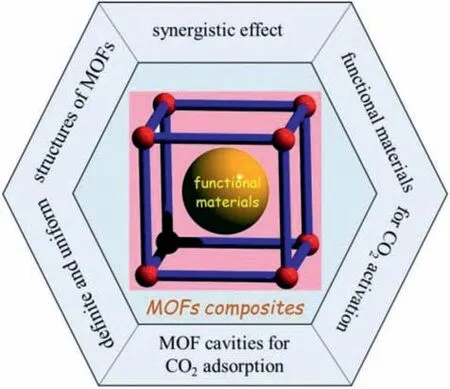
Fig.1.The advantages of MOF composites for the CO2capture and conversion.
This review focuses on the syntheses and catalytic applications towards C3 of MOF composites, which is divided into three sections.The first section gives a brief introduction about the synthetic strategies of MOF composites.The second section discusses the recent progress of MOF composites in C3, including CO2chemical fixation, hydrogenation, photoreduction, electroreduction and photoelectroreduction.The third section summarizes the challenges and future prospects of MOF composites for C3.
2.Synthetic strategies of metal –organic framework composites
In general, the preparation of MOF composites is achieved either via the encapsulation of functional materials in the pores or layers of MOFs or coating MOFs with functional supports/layers 17–20].According to the different types of functional materials,MOF composites that were used for C3 application can be classified into four types as following:
(1) MNPs@MOFs.There were three methods for the preparation of MNPs@MOFs: 1) Ship-in-bottle strategy.The precursors were dispersed inside the pores of MOFs,and followed by the in situ formation of the MNPs via reduction.2) Bottle-around-ship strategy.The MNPs were prepared firstly,and then MOFs grew in situ on the surfaces of the MNPs.3) One-pot synthesis.The MNPs and MOFs were formed simultaneously to afford the MNPs@MOFs.
(2) Semiconductor(or QDs)@MOFs.They could be prepared by the ship-in-bottle or bottle-around-ship strategy.The stability of semiconductor or QDs can be improved by the encapsulation into the pores of the MOFs, and meanwhile their sizedependent electronic or optical properties can be maintained.
(3) Homogeneous molecular catalysts@MOFs.They were prepared via covalent bonding or non-covalent interactions between the molecular catalysts and MOFs.After the homogeneous molecular catalysts were immobilized into MOFs, not only their catalytic performances remained but also the side reactions such as the oxidative self-degradation could be overcome.
(4) Ionic liquids@MOFs (ILs@MOFs).They could be prepared through tandem postsynthetic modification, capillary action or in situ polymerization of ILs inside the MOF pores.After incorporating ILs into MOFs, the resultant ILs@MOFs were formed.
3.Metal-organic framework composites for CO2capture and conversion
3.1.Cycloaddition of CO2and epoxides
Cycloaddition of CO2and epoxides represents one of the few promising industrial processes in which CO2can be utilized under mild temperature and pressure.The value-added carbonate products are important chemical intermediates that can be utilized for a variety of fine chemical synthesis and fabrication of functionalized materials.Enhanced activity and selectivity for the coupling reaction of CO2and epoxides can be achieved through the encapsulation of functional species within the porous framework 21–25].As summarized in Table 1, a range of MOF composites for the CO2chemical conversion have been reported.
Jiang et al.incorporated the imidazolium-based poly(ionic liquid)s (denoted as polyILs) into MIL-101 to prepare the polyILs@MIL-101 via the in situ polymerization of ILs (Fig.2)[21].The composite polyILs@MIL-101 showed a higher isosteric heats of CO2adsorption (Qst) value (44 kJ /mol) at zero coverage than that of MIL-101(26 kJ /mol),indicating that a stronger affinity existed between CO2molecules and polyILs@MIL-101.The synergistic effect from the exposed Lewis acid sites (Cr3+) in MIL-101 and the Lewis base sites()in polyILs contributed to the activation and subsequent reaction of CO2and epoxides.The composite exhibited an excellent catalytic activity toward the cycloaddition of CO2and epoxides under mild conditions (1 bar CO2,70)in the absence of any cocatalyst(Table 1,entry 1).In addition, polyILs@MIL-101 did not show any drop of the catalytic activity at a CO2pressure ranging from 1.5 bar to 0.75 bar, and a decent activity (~80%)can be maintained even under 0.5 bar of CO2pressure.PolyILs@MIL-101 can be recycled for 10 runs without a significant loss of activity.

Fig.2.The preparation of polyILs@MIL-101.Reproduced with permission [21].Copyright 2018, American Chemical Society.

Table 1 Application of MOF composites in the CO2chemical conversion.
Sun and Ma et al.incorporated a linear ionic polymer (IP) into the pores of MIL-101 to afford the IP@MIL-101[22].The Lewis acid site (Cr3+) within the MIL-101 and the nucleophilicity of the Br-ions cooperatively interacted to significantly enhance the catalytic performances.IP@MIL-101 exhibited higher conversions (99%)than the individual parts or a physical mixture of both (Table 1,entry 2).
Yang and Chen et al.developed an in situ defect-formation strategy to obtain the hierarchical mesoCu@Al-bpydc [23].This composite was constructed by the loading of copper precursor Cu(BF4)2into the as-synthesized Al-bpydc via a wet-impregnation method (Fig.3).The defect-mesopore was formed within microporous Al-bpydc.Theanion induced the formation of mesopore within Al-bpydc,and the anchored Cu2+ions functioned as Lewis acid catalysts for the CO2cycloaddition reaction.Under low pressures ( P/P0< 0.2), mesoCu@Al-bpydc presented a much higher CO2sorption capacity than Al-bpydc.Catalytic results showed that mesoCu@Al-bpydc displayed high reactivity and selectivity for the CO2cycloaddition reaction with a range of epoxides,which should be attributed to the active Cu2+Lewis acid sites and bipyridine N basic sites as well as the strong affinity of the composite toward CO2(Table 1, entry 3).Moreover, the hierarchically structure could further enhance the mass transfer efficiency of the substrate.The mesoCu@Al-bpydc can be recycled for 5 runs without loss of activity.
3.2.Reaction of CO2and terminal alkynes
Carboxylation of terminal alkynes is considerably greener over other options for the preparation of propiolic acids, which are important intermediates in chemical and pharmaceutical industries [26,27].MNPs@MOFs can be used for the carboxylation of terminal alkynes with CO228–34].
Ma and Cheng et al.prepared Ag@MIL-101 using a simple liquid impregnation method,and applied the composite in the reaction of terminal alkynes and CO2to prepare propiolic acids[28].Due to the large pore size (2.9–3.4 nm), high specific surface area and longterm chemical stability, MIL-101 was chosen as the support.TEM images disclosed that Ag NPs with an average size of 1.40.4 nm were uniformly dispersed in MIL-101.Catalytic studies showed that under the optimized conditions(1.equiv.Cs2CO3,1 bar CO2,DMF, 50), Ag@MIL-101 could convert the alkyne substrates to the corresponding propiolic acids in excellent yields(Table 1,entry 4).The excellent catalytic activities of Ag@MIL-101 could be explained in three ways: 1) MIL-101 served as CO2reservoirs and then increased the local CO2concentration around Ag NPs, which were the active sites; 2) The inner cavities of MIL-101 provided a platform for the reaction of CO2with terminal alkynes;3) Ag NPs were stabilized by MIL-101.A plausible reaction mechanism was proposed:Through the windows of MIL-101,the terminal alkynes diffused into the inner cavities and reacted with Ag NPs to generate the silver acetylide intermediates in the presence of Cs2CO3.Afterwards, CO2inserted into the C-Ag bond to generate the carboxylic acid products.

Fig.3.The synthesis of mesoCu@Al-bpydc.Reproduced with permission [23].Copyright 2019, Wiley-VCH.
Using an electrostatic self-assembly strategy, Sheng and Zhu et al.incorporated the anionicinto ZIF-8 to obtain the Au12Ag32(SR)30@ZIF-8[29].The high-angle annular dark field scanning transmission electron microscopy (HAADF-STEM),TEM images as well as energy dispersive X-ray (EDX) element mapping disclosed that thenanoclusters were uniformly dispersed in the ZIF-8 matrix.Catalytic studies showed that Au12Ag32(SR)30@ZIF-8 gave rise to 100% conversion of phenylacetylene into phenylpropiolate under mild conditions (50and ambient CO2pressure)(Table 1,entry 5).The turn-over number(TON)was as high as 18164.In addition,the high catalytic activity could be also maintained in five consecutive runs.A possible catalytic mechanism was proposed: Thefirstly activated the terminal alkyne with a base to form aAu12Ag32(SR)30intermediate I, and then CO2was fixed and activated by ZIF-8 to generate an intermediate CO2-Lewis acid complex II.Subsequently, the activated CO2inserted into the nearby Au –C bond to afford the carboxylate III.Finally, the intermediate I was regenerated by the metathesis with alkyne (Fig.4).
The different locations of MNPs relative to the MOFs in the composites contributed differently to the reaction efficiency.Sun and Wei et al.prepared 0.5Ag@ZIF-8(where 0.5 represents the Ag/Zn ratio in the preparation mixtures)by rapidly contacting AgNO3and ZIF-8 in methanol at 0.Two types of Ag species were installed, including the highly dispersed Ag(I) in the backbone(AgHD)and the aggregated Ag(0)nanoparticles on the outer surface(AgNP)[30].Under the optimized condition,0.5Ag@ZIF-8 promoted the carboxylation of terminal alkynes with CO2into the corresponding propiolic acids in good to excellent yields (Table 1,entry 6).The coexistence of AgHDand AgNPhad a profound effect on the catalytic performances: On one hand, AgNPwere highly effective for the activation of terminal alkynes, and on the other hand,the modification of ZIF-8 framework with AgHDenhanced its CO2affinity and thus improved the CO2activation.The 0.5Ag@ZIF-8 can be recycled for 4 runs with a negligible alteration on the crystallinity and morphology.
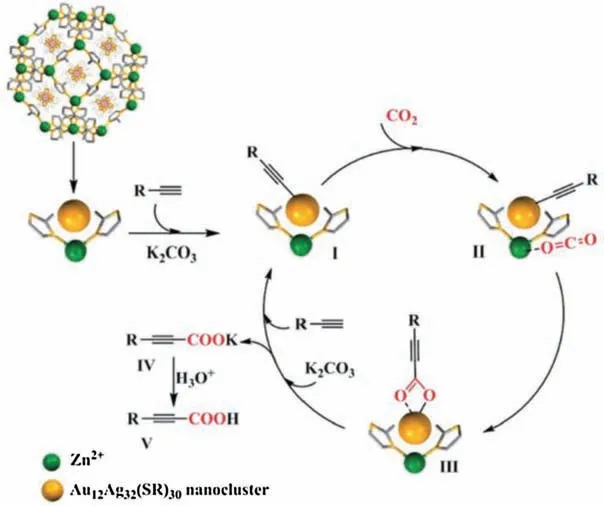
Fig.4.Proposed reaction mechanism toward CO2and phenylacetylene over Au12Ag32(SR)30@ZIF-8.Reproduced with permission [29].Copyright 2018, Royal Society of Chemistry.

Table 2 Application of MOF composites in CO2hydrogenation.
3.3.CO2hydrogenation
3.3.1.CO2-to-CH3OH
CO2hydrogenation can not only slow down the rising CO2level in Earth ’s atmosphere, but also produce value-added chemicals such as methanol and formate.The Cu/ZnO/Al2O3is used as an industrial catalyst for CO2hydrogenation to prepare methanol,but however CO was observed as the byproduct due to the reverse water-gas shift reaction [35].
Yaghi and Somorjai et al.reported the synthesis of Cu@UiO-66,which was efficient for CO2hydrogenation at 175and 10 bar(CO2and H2in the 1: molar ratio)and produced methanol with 100% selectivity [36] (Table 2, entry 1).The turn-over frequency(TOF)was calculated to be 10]which was 8 times of that of the benchmark Cu/ZnO/Al2O catalyst.XPS results disclosed that the Zr 3d binding energy in Cu@UiO-66 was shifted toward lower oxidation state compared to UiO-66, implying that the Zr(IV)was reduced after being in contact with the Cu NPs due to the metalsupport interaction effect.
The Cu/ZnOxinterfaces were widely used for CO2hydrogenation, but however, Cu NPs slowly aggregated and separated from ZnOxunder the reaction conditions, reducing the Cu/ZnOxinterfaces and thus diminishing the catalytic activity.Wang and Lin et al.prepared the Cu/ZnOx@UiO-bpy (bpy =2,20-bipyridine)composite by anchoring the ultrasmall Cu/ZnOxnanoparticles in the framework of UiO-bpy,which can prevent the agglomeration of Cu NPs and phase separation between Cu and ZnOx[37].Cu/ZnOx@UiO-bpy was prepared by the coordination of the Cu2+ions into the bpy sites that were located in UiO-bpy through the postsynthetic metalation, and followed by the incorporation of Zn2+ions via their reactions with the m3-OH sites on the Zr-O SBUs of UiO-bpy.The ultrasmall Cu/ZnOxNPs were then in situ generated within UiO-bpy at 250in the presence of H2as the reductant,giving rise to Cu/ZnOx@UiO-bpy.Catalytic studies showed that Cu/ZnOx@UiO-bpy-catalyzed CO2hydrogenation produced methanol with yields up to 2.59 gMeOHkgCuand 100% selectivity at 250and under a pressure of 40 bar with a H2/CO2ratio of 3(Fig.5; Table 2, entry 2).
Due to the photothermal effect, the plasmonic Ag and Au NPs can increase the reaction temperature after the irradiation of light.Zeng and co-workers prepared Au&Pt@ZIF-8 via the encapsulation of Pt nanocubes and Au nanocages into ZIF-8, in which the Au nanocages transformed light to thermal energy, the Pt nanocubes served as the catalyst toward CO2hydrogenation,ZIF-8 functioned as “heat insulators” to prevent heat from dispersing in solution[38].Au&Pt@ZIF displayed a high TOF value of 1522 hfor the synthesis of methanol under the light irradiation, which was 13 times higher than the controlled experiment in the dark(Table 2,entry 3).The high catalytic performance can be maintained for 6 runs.
3.3.2.CO2-to-HCOO
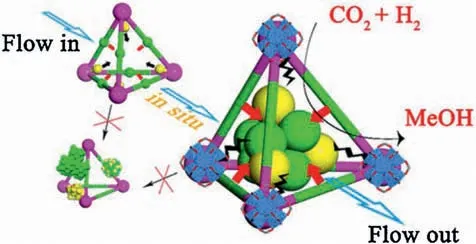
Fig.5.Catalytic behavior of Cu/ZnOx@UiO-bpy composite in CO2hydrogenation.Reproduced with permission [37].Copyright 2017, American Chemical Society.

Fig.6.Catalysis in MOFs using aperture-opening encapsulation.Reproduced with permission [39].Copyright 2018, American Chemical Society.
Byers and Tsung et al.developed an active catalyst of Ru@UiO-66 for the hydrogenation of CO2to formate(Fig.6)[39].(tBuPNP)Ru(CO)HCl (tBuPNP=2,6-bis((di-tert-butyl-phosphino)methyl)pyridine)was used for the precursor.Catalytic CO2hydrogenation studies were studied at 27and under 15 bar with a H2/CO2ratio of 4,which showed that Ru@UiO-66 gave rise to HCOO-with a TOF value of 6105(Table 2,entry 4).Moreover,Ru@UiO-66 can be recycled for 5 runs without loss of activity.
3.3.3.CO2-to-CH4
CO2hydrogenation can also produce CH4, which is also called the Sabatier reaction and is an important catalytic process to eliminate the CO2concentration and generate the clean CH4fuel.Lu and co-workers prepared Ni@MOF-5, in which Ni NPs were highly dispersed (41.8%) over MOF-5 [40] (Table 2, entry 5).The Ni@MOF-5 composite showed high activity at low temperature and exhibited almost no deactivation in the long-term stability tests up to 100 h.
Later, this group reported a 20Ni@MIL-101 (where 20 indicate that the nickel loading was 20%) composite by encapsulating Ni NPs in MIL-101 via a double solvent method (DSM) [41].20Ni@MIL-101 exhibited a high thermal stability and a low activation energy(88 kJ/mol)for CO2hydrogenation,giving rise to CH4with a high TOF value ofat 300(Table 2,entry 6).The density-functional theory (DFT) calculations uncovered that the potential energy barrier was about 10.0 kcal /mol for CO2dissociation into COadsand Oadsover the Ni (1 1 1) surface,which was lower than Ni (200) plane (20.3 kcal/mol).
Cheang and Xu et al.prepared a Ni@UiO-66 composite through the adsorption of Ni2+ions into the cavity of UiO-66, and then in situ reduction under a 5%H2/Ar atmosphere at 250(Fig.7)[42].The uniform distribution of Ni NPs with an average size of 2 nm throughout the UiO-66 framework was revealed by the HAADFSTEM and EDX elemental mapping.Compared with Ni/ZrO2and Ni/SiO2, Ni@UiO-66 exhibit outstanding activity and high selectivity for CO2methanation at low temperatures(Table 2,entry 7),which is due to the good dispersion of ultrasmall Ni NPs and the low activation energy (Ea= 68.9 kJ/mol).
3.4.CO2photoreduction
3.4.1.MNPs@MOFs or MNPs/MOFs
CO2photoreduction is a process that uses renewable solar energy to transform CO2into products with different oxidation state,e.g.,CO,CH3OH and CH4.MOFs have been extensively studied for heterogeneous CO2reduction, but however, the catalytic efficiency is far from satisfactory.The efficiency can be improved through incorporating precious metal nanoparticles to MOFs to form MNPs@MOFs (or MNPs/MOFs.MNPs@MOFs herein refers to that the MNPs are incorporated into the inner cavities of the MOFs,while MNPs/MOFs refers to that the MNPs are loaded on the external surfaces of the MOFs):1)MNPs can serve as electrons trapping sites, promote the charge separation, suppress the electron-hole recombination, and behave as active reaction sites for the CO2reduction[43,44];2)Some noble MNPs such as Cu,Ag and Au NPs display localized surface plasmon resonance (LSPR)effect, which can boost the visible-light harvesting capabilities of MOFs composites 45–48].
The doping of noble metals such as Pt and Au into the MOFs is generally a feasible strategy to inhibit the recombination of the photo-generated electrons and holes[43,44].Wang and Sun et al.embedded Pt NPs inside and/or outside of NH2-UiO-68[43].As for 2 wt% Pt@NH2-UiO-68, in which Pt NPs were located inside NH2-UiO-68, showed the highest CO2photoreduction activity (66.7for CO)under visible light irradiation(Table 3,entry 1).Pt NPs with an appropriate location and content in the resulting composites could facilitate the contact between Pt NPs and NH2-UiO-68,thereby achieving efficient charge transfer in the photocatalytic process.More importantly, an effective charge transfer from NH2-UiO-68 to the excited Pt NPs via the Schottky junction could inhibit the recombination of photogenerated charge carriers.
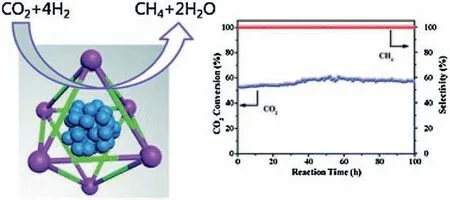
Fig.7.Ni@UiO-66 composite give both excellent activity and selectivity for CO2methanation at low temperature.Reproduced with permission [42].Copyright 2018, Royal Society of Chemistry.
Zhang and Li et al.prepared M-doped NH2-MIL-125(Ti)(M=Pt and Au)composites and studied their catalytic applications in CO2photoreduction under visible-light irradiations in the presence of TEOA [44].Pt and Au NPs played different effects on the catalytic performances.Compared to NH2-MIL-125(Ti),Pt/NH2-MIL-125(Ti)showed an enhanced activity for formate production,whereas Au/NH2-MIL-125(Ti) had a negative effect on this reaction (Table 3,entries and 3).Based on ESR and DFTcalculations,the mechanism studies about Pt/NH2-MIL-125(Ti)-catalyzed reaction disclosed that the hydrogen could spillover from Pt to the bridging oxygen atoms that were linked to Ti atoms, resulting in the formation of Ti3+and an improved performance for CO2reduction to generate formate.However,it is unlikely to happen for Au/NH2-MIL-125(Ti),which might explain its lower reaction efficiency.
Yang and Yaghi et al.reported a core-shell AgRe3MOF composite, which was prepared by coating the Re3-MOF layers onto the pre-synthesized Ag nanocubes (98 nm) (Fig.8) [45].The strong quadrupolar LSPR scattering peak (lmax480 nm) of Ag nanocube overlaped with the absorption range of the Re3MOF(400 nm <<550 nm).And therefore, AgRe3MOF could maintain the characteristic LSPR features of the Ag nanocubes,and meanwhile the photoactive Re centers were spatially confined to the intensified near-surface electric fields at the surface of Ag nanocubes, contributing to a 7-fold enhancement of CO2-to-CO conversion under visible light compared to Re3MOF (Table 3,entry 4).
Owing to the LSPR characteristic of Ag NPs, the decorating Ag NPs onto the MOFs surface can further expand the absorption capability of the resultant Ag/MOF composites to the near IR region 46–48].Huang, Sun and coworkers prepared Ag/MIL-101(Cr) in which Ag NPs with the size range of 80-800 nm were welldispersed on the outer surface of the MIL-101(Cr)framework[46].Catalytic studies showed that the photocatalytic activity of Ag/MIL-101(Cr)exhibited a strong dependence on the composite size of MIL-101(Cr), and the highest CO2photocatalytic reduction activities up to 808.2 and 427.5 mmolfor CO and CH4,respectively(Table 3,entry 5),were achieved when the size of Ag/MIL-101(Cr) was reduced to 80 nm.A set of photochemical and electrochemical studies revealed that the high catalytic performance might be ascribed to the high density of unit cells on corners and edges of Ag/MIL-101(Cr),which was beneficial to the electron transfer in the photocatalytic CO2reduction.
Chen,Duan and co-workers have loaded the plasmonic Au NPs on the surface of a thin porphyrin paddle-wheel framework-3(PPF-3) nanosheets by electrostatic interaction, giving rise to the Au/PPF-3 composites [47].The Au NPs could serve as the lightharvesting antenna due to its strong SPR absorption peaks at 525 nm.The Au/PPF-3 composite showed a high photocatalytic activity for CO2reduction into HCOO-with an average production rate of 42.7 mmolunder visible-light irradiation (Table 3,entry 6),which was around 4-fold higher than that of the pristine PPF-3.Further mechanism studies disclosed that the catalytic efficiency improvement of CO2conversion intoover Au/PPF-3was through a plasmon resonance energy transfer process from AuNPs to PPF-3 (Fig.9).
The product selectivity of CO2reduction in the presence of MNPs@MOFs can be summarized as follow: Au/MOFs generatePt@MOFs or Pt/MOFs give rise to the production of CO orwhereas Ag/MOFs composites produce CO or CH4.
3.4.2.Molecular catalysts@MOFs
The incorporation of molecular catalysts or photosensitizers into the pores of MOFs provides an efficient way to engineer the MOF composites for enhanced photocatalytic CO2reduction[49,50].Fontecave,Mellot-Draznieks and co-workers immobilized the molecular catalyst [Cp*Rh (4,40-bpydc)]2+and thephotosensitizer [Rh(bpy)2(4,40-bpydc)]2+into the highly porous MIL-101-NH2(Al) via an easy post-synthetic impregnation, giving rise to the Rh –Ru@MIL-101-NH2composites[49].The large cavity of MIL-101-NH2(Al) as a nanoreactor allowed the intimate confinement of the catalyst and the photosensitizer.Catalytic studies showed that Rh –Ru@MIL-101-NH2exhibited a remarkable selectivity towards CO2reduction under visible light irradiation,and producedwith the rate of 13.2 mmol(Table 3,entry 7).The H2production was totally suppressed,which was in deep contrast to the molecular catalyst alone.There was a negligible leaching of the active species in Rh –Ru@MIL-101-NH2during photocatalysis, which was due to the strong host –guest interactions.
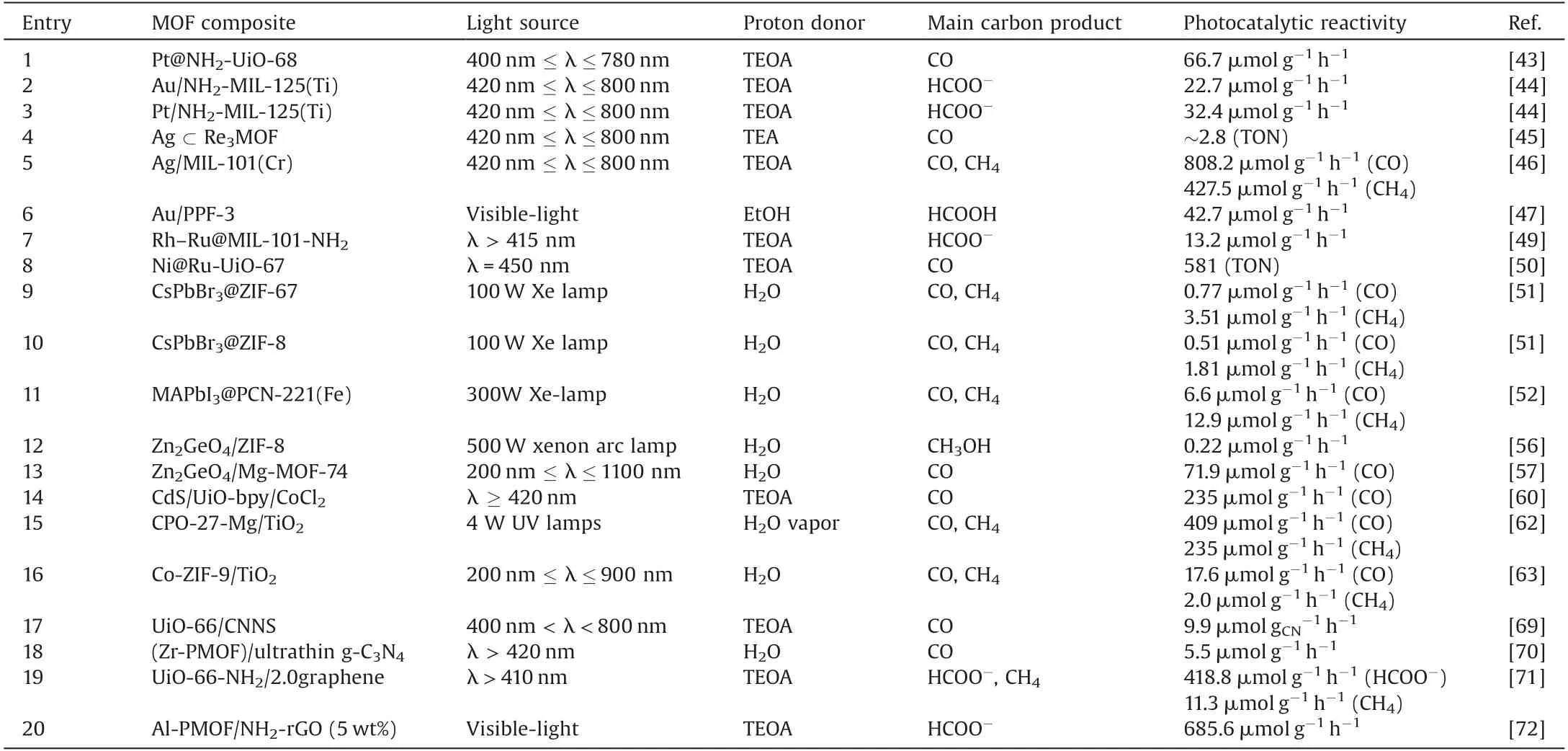
Table 3 Application of MOF composites in the photocatalytic CO2reduction.
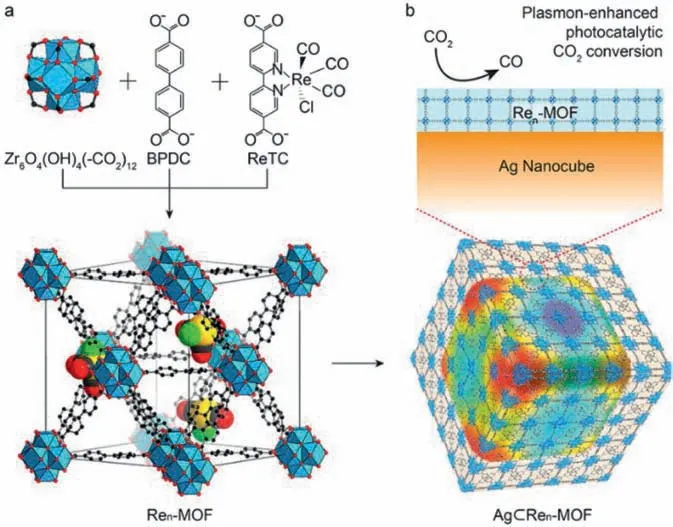
Fig.8.Structures of Ren-MOF and Ag Ren-MOF for plasmon-enhanced photocatalytic CO2conversion.Reproduced with permission [45].Copyright 2017,American Chemical Society.
Using the “ship-in-bottle”synthetic strategy,Jin and Kong et al.encapsulated a molecular catalyst[NiII(bpet)(H2O)2](bpet=1,2-bis((pyridin-2-ylmethyl)thio)ethane)into a highly robust and visiblelight responsive Ru-UiO-67 to obtain Ni@Ru-UiO-67(Fig.10)[50].Ni@Ru-UiO-67 exhibited an efficient CO2reduction to CO with a TON of 581 and a high selectivity of 99%under the irradiation with a LED light (82 W) (Table 3, entry 8).Photoluminescence (PL)measurements showed the facile electron transfer from the excited Ru-MOFs to the encapsulated Ni(II)complex,which was crucial for the excellent activity of Ni@Ru-UiO-67.Advanced ultrafast absorption spectroscopy and DFT calculations further disclosed that the photoelectrons that were produced by the Ru ligand could transfer to the Ni(II) complex, affording Ni0species for the reduction CO2to CO.
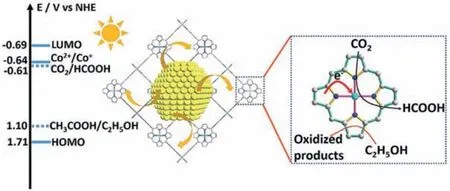
Fig.9.Proposed mechanism for plasmon-enhanced photocatalytic activity of Au/PPF-3 towards CO2reduction.Reproduced with permission [47].Copyright 2019,Royal Society of Chemistry.
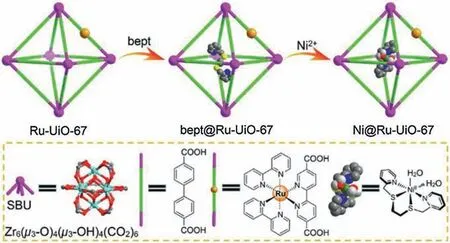
Fig.10.Schematic illustration for “Ship-in-a-Bottle” synthetic strategy to prepare Ni@Ru-UiO-67 composite.Reproduced with permission [50].Copyright 2019,Elsevier.
3.4.3.QDs@MOFs
QDs are fluorescent semiconductor nanoparticles with the size range of 1–10 nm, which possess high quantum yield and strong light capture ability.Engineering MOFs and QDs to form QDs@MOFs can accelerate the separation of photogenerated charges, inhibit the recombination of photogenerated electrons and holes,and thus enhance the photocatalytic performance of the resultant composites due to the close inter-face and matched band gap between QDs and MOFs [51,52].
Chen ’s group immobilized ZIF-8 and ZIF-67 on the surface of CsPbBr3quantum dot to afford CsPbBr3@ZIFs with an improved moisture stability, photo-generated charge separation efficiency and CO2capturing ability [51].CsPbBr3@ZIF-67 exhibited the broadened visible light absorption that was extended to 620 nm.The inhibited photo-generated carrier radiative recombination and effective electron transfer between CsPbBr3and ZIFs were confirmed by the steady-state and time-resolved photoluminescence studies.The CoIIcenter in ZIF-67 served as an electron reservoir to accelerate the separation of photo-induced carriers.Catalytic studies showed that only CO and CH4were detected,and the yield of CH4(10.5 mmol/g) was much higher than that of CO (2.3 mmol/g).The higher selectivity of CH4was attributed to the solid-gas mode catalytic reaction condition with water vapor involved, which can provide sufficient protons and help to overcome the dynamic barrier to produce CH4.Moreover, Both CsPbBr3@ZIF-8 and CsPbBr3@ZIF-67 exhibited enhanced CO2reduction activities,which were 1.39- and 2.66-fold, respectively,of the naked CsPbBr3(Table 3, entries 9 and 10).
Zhang and Lu et al.prepared a series of MAPbI3@PCN-221(Fex)(x =0–1) composites by encapsulating CH3NH3PbI3(MAPbI3)perovskite QDs in the pores of PCN-221(Fe) through a sequential deposition route(Fig.11)[52].As revealed by the steady-state and time-resolved photoluminescence experiments, the photo-generated electrons of the encapsulated MAPbI3QDs under light irradiation quickly transferred to the photocatalytic Fe-porphyrin units of PCN-221(Fe), and thereby an efficient charge separation between the perovskite QDs and the MOF was achieved.Catalytic results disclosed that a high total yield of 1559 mmol/g for photocatalytic CO2reduction to CO (34%) and CH4(66%) was achieved using water as an electron source, which was 38 times higher than that of PCN-221(Fe0.2)in the absence of perovskite QDs(Table 3, entry 11).

Fig.11.Schematic illustrations for the synthesis of a)PCN-221(Fex),and b)MAPbI3QDs (large spheres) encapsulated in the pores of PCN-221(Fex) by a sequential deposition route.Reproduced with permission [52].Copyright 2019, Wiley-VCH.
3.4.4.MOFs/semiconductors
Coupling MOFs with semiconductors has been proved to be an effective strategy to boost the catalytic performance in the photocatalytic CO2reduction.The resultant MOF composites can display an improved separation efficiency of photo-generated electrons.The most common semiconductors that are used in the MOFs composites fabrication include Zn2GeO4, CdS, TiO2and carbon nitride.
Zn2GeO4is widely used in the photocatalytic reduction of CO2,which shows high crystallinity and light/thermal stability,but the weak CO2adsorption and low solar energy utilization efficiency largely inhibit its practical applications 53–55].To overcome these shortcomings,Wang et al.immobilized ZIF-8 nanoparticles on the surfaces of Zn2GeO4nanorods to obtain the ZIF-8/Zn2GeO4composite, which inherited the high CO2adsorption property of ZIF-8 and the high crystallinity of Zn2GeO4(Fig.12) [56].ZIF-8/Zn2GeO4with 25 wt%ZIF-8 displayed 3.8 times higher CO2uptake than Zn2GeO4, which could effectively absorb CO2that was dissolved in water.Catalytic studies showed that ZIF-8/Zn2GeO4exhibited 62% enhancement in photocatalytic conversion of CO2into CH3OH (Table 3, entry 12).
Later,Gao and Cao et al.prepared Mg-MOF-74/Zn2GeO4through a hydrothermal method, and a close interaction was formed between Zn2GeO4and Mg-MOF-74 [57].The composite displayed high efficiency in photocatalytic CO2to CO using only water as the sacrificial agent,with an evolution rate of 71.9 mmol g-1h-1,which was 7 times higher than that of Zn2GeO4(Table 3, entry 13).The enhanced photocatalytic performances were attributed to the higher CO2adsorption and the slower recombination of photogenerated e-h pairs of Mg-MOF-74/Zn2GeO4than Zn2GeO4.Mechanistic studies disclosed that the photo-generated electrons could effectively transfer from Zn2GeO4to the open alkaline metal sites (Mg2+) of Mg-MOF-74 for the subsequent CO2reduction.
As an excellent visible-light response semiconductor, CdS has been extensively used as photo-catalyst for CO2reduction, but unfortunately, its applications are limited due to the fast recombination of photo-generated electron-hole pairs,the serious photo-corrosion, and the low CO2adsorption capability [58,59].Wu, Han and co-workers fabricated a ternary CdS/UiO-bpy/CoCl2composites, in which the semiconductor CdS and the molecular redox catalyst CoCl2were integrated through UiO-bpy [60].The composite was highly efficient in the photocatalytic conversion of CO2to CO under visible light irradiation,giving rise to an evolution rate of 235 mmoland 85% selectivity (Table 3, entry 14).
TiO2is a benchmark inorganic semiconductor for CO2photoreduction [61].Li et al.prepared a CPO-27-Mg/TiO2composite through an in situ growth method,which was composed of TiO2nanospheres that grew on the surfaces of spindle-shaped CPO-27-Mg microcrystal [62].The coordination between the carboxylate groups of CPO-27-Mg and Ti4+of TiO2resulted in the intimate contact between MOF and semiconductor (Fig.13).Catalytic studies showed that CPO-27-Mg/TiO2exhibited an enhanced performance for the photoreduction of CO2to CO and CH4, and meanwhile the reduction of H2O to form H2was totally inhibited (Table 3, entry 15).

Fig.12.Synthesis of ZIF-8/Zn2GeO4composite.Reproduced with permission [56].Copyright 2019, Royal Society of Chemistry.
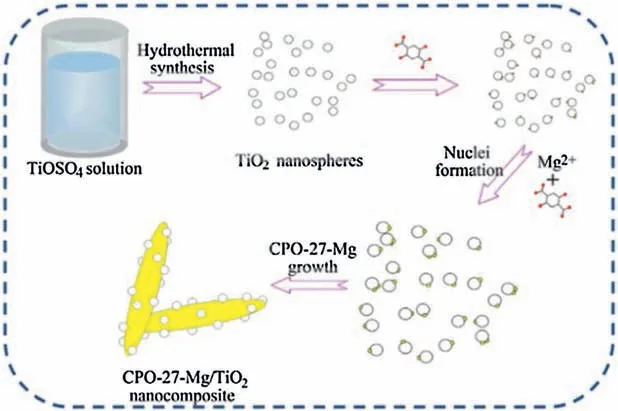
Fig.13.Schematic illustration of the formation of CPO-27-Mg/TiO2nanocomposite.Reproduced with permission [62].Copyright 2016, Elsevier.
Using a similar strategy, Xu and Ye et al.reported a Co-ZIF-9/TiO2composite, in which TiO2and Co-ZIF-9 were closely bound with each other,thus leading to better charge separation[63].The composite exhibited an enhanced total utilized photoelectron number(UPN),which was about 2.1 times of the pure TiO2(Table 3,entry 16).Linear sweep voltammetry disclosed that a more positive onset potential for CO2reduction and higher photocurrent density in the simulated photoelectron reduction of CO2was achieved in the composite,which indicated a better CO2activation and superior charge separation.
As a metal-free and visible-light active photocatalyst,graphitic carbon nitride (CN) has been applied in the photocatalytic CO2reduction [64,65].However, due to the fast recombination of the photogenerated electron –hole pairs, the efficiency of bulk carbon nitride (bulk CN) is not satisfactory.These drawbacks can be overcome by the exfoliation of bulk CN to 2D atomic carbon nitride nanosheet(CNNS),leading to the improved photocatalytic activity 66–68].Due to the low CO2adsorption capability of carbon nitride, further improvement of the efficiency is still a challenge.
Ye and co-workers prepared a UiO-66/CNNS composite through the electrostatic reaction between the negatively charged nanosized CNNS and positively charged UiO-66 [69].As confirmed by the TEM image of the UiO-66/CNNS composite, the CNNS were coated on the surface of UiO-66.Furthermore, the nanojunctions between the UiO-66 crystal and the CNNS were revealed by a distinguished and coherent inter-face HRTEM image,which could give rise to an efficient electron transfer.In addition, the UiO-66/CNNS composite showed a superior CO2uptake ability than that of CNNS.Photocatalytic CO2reduction in the presence of UiO-66/CNNS produced CO in the yield of 9.9 mmolwhich was three times than CNNS(Table 3,entry 17).A tentative mechanism for the photocatalytic CO2reduction over UiO-66/CNNS was proposed as follow (Fig.14): upon visible light irradiation,electrons were promoted from the valence band of CNNS to its corresponding conduction band.Then the photogenerated electrons migrated to the surface of CNNS and transferred to UiO-66 across the interface between CNNS and UiO-66.Subsequently,the adsorbed CO2was reduced to CO.
Zhang and Zhong et al.prepared a series of Zr-porphyrin metalorganic framework (Zr-PMOF)/ultrathin g-C3N4composites, in which hollow Zr-PMOF nanotubes were surrounded by 3D ultrathin g-C3N4, leading to an interfacial interaction [70].The interaction provided a platform for g-C3N4as a conductor to obtain electrons from ligands or as a donor to transfer electrons to Zr-O cluster of Zr-PMOF.The composite exhibited a CO evolution rate of 5.5 mmolin the CO2reduction (Table 3, entry 18), which was 2.2 and 3.2 times higher than Zr-PMOFs and g-C3N4,respectively.

Fig.14.Proposed mechanism of photocatalytic reduction of CO2by the UiO-66/CNNS heterogeneous photocatalyst under visible light irradiation.Reproduced with permission [69].Copyright 2015, Wiley-VCH.
3.4.5.MOFs/graphene
To improve the conductivity of MOFs, engineering MOFs/graphene composites is a feasible strategy, considering that graphene has unique two-dimensional structure, outstanding electrical and thermal properties, and efficient electron transfer ability.Therefore,MOFs/graphene composites would be promising materials for photocatalytic reactions [71,72].
Li ’s group prepared UiO-66-NH2/graphene composite via a microwave-induced synthesis route by in situ assembly of UiO-66-NH2onto graphene [71].UiO-66-NH2crystals were highly dispersed on the surface of graphene, and the tight junctions between UiO-66-NH2and the surface of graphene was formed.The UiO-66-NH2/2.0graphene composite displayed a strong CO2uptake about 73 cm3/g.Catalytic studies showed that UiO-66-NH2/2.0graphene exhibited a high activity (418.8 mmol g-1h-1)and good selectivity (78.6%) in the photocatalytic CO2to formic acid under visible-light irradiation (l>410 nm, 300 W Xe lamp)(Table 3, entry 19).Controlled experiments disclosed that the introduction of graphene could suppress the competitive reaction of hydrogen evolution.The high CO2photo-reduction activity and excellent recyclability might attribute to the highly dispersion of UiO-66 ultrafine nanocrystals on the surfaces of graphene and the strong interaction between UiO-66 and graphene (Fig.15).
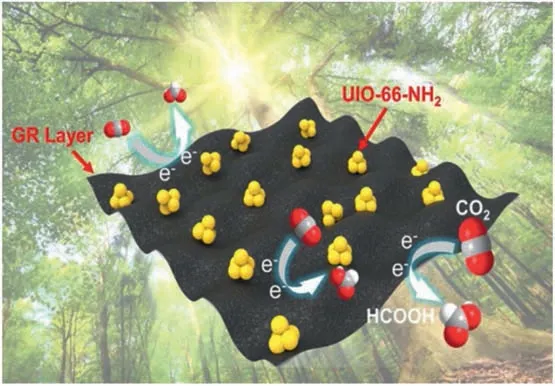
Fig.15.The working mechanism of the UiO-66-NH2/2.0graphene composite for reducing CO2to formic acid under visible light irradiation.Reproduced with permission [71].Copyright 2018, Elsevier.
Do and co-workers prepared Al-PMOF/NH2-rGO (GO=graphene oxide) that was composed of a porphyrin metal –organic framework Al-PMOF and amine-functionalized graphene (NH2-rGO) [72].Photoluminescence and Mott-Schottky measurements disclosed that the band gap was decreased and electron –hole recombination was suppressed in the resultant composite.In the presence of Al-PMOF/NH2-rGO (5 wt%), photoreduction of CO2under visible light irradiation in the presence of TEOA as a sacrificial agent led to the formation ofwith almost 100%selectivity and an evolution rate of 685.6 mmolunder visible light irradiation(Table 3,entry 20),which was 76%greater than that of Al-PMOF.The N species on the rGO contributed to the catalytic efficiency of Al-PMOF/NH2-rGO (5 wt%) in two ways:firstly,the N species on rGO enabled the connection of PMOF with the graphene and electron transfer from the excited PMOF to the graphene sheet; secondly, the amine groups of rGO could also absorb light and thereby boost the light-harvesting capability of the composite.The proposed reaction mechanism was illustrated as following: After being excited under light illumination, the ligand TCPP in Al-PMOF behaved as a visible-light-harvesting unit,and the electrons transferred from TCPP to graphene while the holes remained in the TCPP.Subsequently, the electrons from graphene transferred to the adsorbed CO2and led to the reduction of CO2towards HCOO-in the presence of TEOA acting as a hydrogen source.
3.5.CO2electroreduction
Electrochemical reduction of CO2using renewable energy is one of the most promising approaches for CO2conversion to valuable products.The main challenges lie in the field of CO2electroreduction are the low selectivity, faradaic efficiency and catalytic efficiency.
Li and Bao et al.reported electrocatalytic applications of Ag2O/ZIF-7, which was prepared through one-pot hydrothermal treatment of ZIF-7 in AgNO3aqueous solution [73].Catalytic studies disclosed that the faradaic efficiency and current density of Ag2O/layered ZIF composite for CO2electroreduction to CO reached 80.5% and 26.2 mA/cm2at -1.2 V vs.the reversible hydrogen electrode (RHE), respectively, under CO2-saturated 0.25 mol/L K2SO4solution (Table 4, entry 1).
Yu and Qiu et al.fabricated Cu2O@Cu-MOF for the electrochemical reduction of CO2[74].Catalytic studies disclosed that the Cu2O@Cu-MOF exhibited an excellent performance with a 79.4%faradaic efficiency for hydrocarbon (CH4+C2H4), and especially 63.2% faradaic efficiency for CH4(Table 4, entry 2).The high electrocatalytic activity and high selectivity to CH4was attributed to the multiple functionalities of Cu2O@Cu-MOF, such as absorption, activation, and catalysis derived from synergistic effects of Cu-MOF and Cu2O.
Metallocene complexes(MCp2,Cp stands for cyclopentadienyl)are electron-rich with high stability and aromaticity, which can serve as potential electron donator and carrier to enrich the electron density of MOFs [75].Chen and Lan et al.developed a CoCp2@MOF-545-Co composite for the highly selective CO2electroreduction [76].The composite was prepared by the incorporation of CoCp2into the pores of MOF-545, which display high porosity, large pore size (3.6 nm) and excellent chemical/thermal stability that can serve as an ideal platform to interact with CoCp2.In the resultant CoCp2@MOF-545-Co composite, the p-electron system of cyclopentadienyl ring might overlap with pelectron system of porphyrin,which would endow MOF-545 with higher CO2adsorption capability,larger number of active sites and more favorable electron transfer property to largely enhance the electrocatalytic activity.Catalytic studies disclosed that CoCp2@-MOF-545-Co selectively converted CO2to CO with 97% Faradaic efficiency under CO2-saturated 0.5 mol/L KHCO3(pH 7.2) solution(Table 4, entry 3).Mechanistic studies suggested that the continuous electron transfer channel in MOFs could be created through the introduction of metallocene, and meanwhile the adsorption energy of CO2can be largely reduced by the strong binding-interaction with metalloporphyrin, which contributed to the excellent activity of CoCp2@MOF-545-Co in the CO2electroreduction (Fig.16).
3.6.CO2photoelectroreduction
An alternative approach for CO2transformation is the CO2photoelectroreduction, which integrates photocatalysis and electrocatalysis [11].Photoelectrocatalytic reduction of CO2would reduce electricity consumption as compared to the CO2electroreduction because of the introduction of solar energy.Moreover,as compared to CO2electroreduction,CO2photoelectroreduction may achieve higher efficiency because the applied external bias voltage can drive the separation of photo-generated electrons and holes,which is the most crucial step in limiting the photocatalytic efficiency.

Fig.16.The schematic presentation for the advantages of MCp2@MOF in electrocatalytic CO2RR.Reproduced with permission[76].Copyright 2020,Elsevier.

Table 4 Application of MOF composites in the electrocatalytic CO2reduction.

Fig.17.The schematic presentation of Ti/TiO2NT-ZIF-8 composite for the photoelectrocatalytic reduction of CO2to produce methanol and ethanol fuels.Reproduced with permission [77].Copyright 2018, Elsevier.
Cardoso and co-workers reported the synthesis of Ti/TiO2NTZIF-8 composite for the photoelectrocatalytic reduction of CO2to produce CH3OH and C2H5OH (Fig.17) [77].The composite was prepared by the growth of ZIF-8 nanoparticles on the Ti/TiO2nanotubes through a layer-by-layer process.Photoelectrocatalysis of the Ti/TiO2NT-ZIF-8 electrodes gave rise to the formation of up to 0.7 mmol/L of CH3OH and 10 mmol/L of ethanol in 0.1 mol/L Na2SO4at room temperature.The ZIF-8 not only participated in the CO2adsorption/activation,but also functionalized as a co-catalyst.
4.Conclusion and future outlook
In summary, the syntheses and catalytic applications of MOF composites towards CO2capture and conversion (C3), including chemical fixation, hydrogenation, photoreduction, electroreduction and photoelectroreduction of CO2have been discussed.Although MOF composites have great potentials towards C3 application, this research field is still in its infancy: Firstly, the chemical and thermal stability of MOF composites should be further improved.Secondly,the scalable and efficient preparation methods for MOF composites are highly desired.Until now, the fabrication of MOF composites for the target CO2conversion is still in the laboratory scale by time-consuming procedures, which restricts their industrial-scale applications.Thirdly, a deep understanding of the interactions between MOFs and functional materials is still not sufficient.In-depth studies of the interfacial interactions can guide the design of the next generation of MOF composites for CO2activation.
For the CO2chemical fixation, more types of transformations should be explored to convert CO2into abundant value-added chemicals,which will open new ways for the CO2utilization using MOF composites as catalysts.And especially,MOF composites that can promote the transformations of CO2at room temperature,atmospheric pressure and low CO2concentrations are highly desired, but however only a few relevant studies have been reported.As for the CO2hydrogenation,MOF composites that can promote the reaction under atmospheric pressure and room temperature are highly desired, considering that some MOFs are unstable at high temperatures.
For the photocatalytic reduction of CO2, several problems remain to be solved.Firstly,the main products of MOF composites for the photocatalytic CO2reduction are limited to C1compounds(e.g.CO, CH4, HCOOH and CH3OH) and C2compound (e.g.CH3CH2OH),but the reports about the C3+products(hydrocarbons with more than three carbons) are rare.Secondly, the detailed mechanism of photocatalytic CO2reduction on the MOF composites is still unclear.The combination of advanced characterizations and density functional theory calculations should be an efficient way to for the deep study of the structure –activity relationship,which is of vital importance to the rational design of MOF composites.Finally, most of the present catalytic systems need additional sacrificial regents, which is not economically feasible.Coupling the photocatalytic CO2reduction with oxidative organic reaction is an efficient strategy to tackle this problem,which produces solar fuel and value-added organic chemicals simultaneously.As for the CO2electroreduction, MOF composites that are based on earth-abundant metal elements and possess a good compromise of high faradaic efficiency and selectivity are highly required.
In conclusion, MOF composites as heterogeneous catalysts for the CO2capture and conversion are showing bright future and will no doubt attract more attention in the CO2chemistry.The next challenge is to tackle the drawbacks of MOFs composites and put them into practical applications.
Declaration of competing interest
The authors declared that they have no conflicts of interest to this work.They also declared that they do not have any commercial or associative interest that represents a conflict of interest in connection with the work submitted.
Acknowledgments
The authors acknowledge the support from the National Natural Science Foundation of China (Nos.21773314,21720102007, 21821003 and 21890382), the Guangdong Natural Science Funds for Distinguished Young Scholar (No.2019B151502017),the Tip-top Youth Talents of Guangdong special support program(No.20173100042150021),Science and Technology Planning Project of Guangzhou (No.201707010168), the General Financial Grant from the China Postdoctoral Science Foundation (No.2019M662809), and Local Innovative and Research Teams Project of Guangdong Peal River Talents Program(No.2017BT01C161).
杂志排行
Chinese Chemical Letters的其它文章
- Quantitative assessment of rhodamine spectra
- Copper-cobalt-nickel oxide nanowire arrays on copper foams as self-standing anode materials for lithium ion batteries
- Design of activatable red-emissive assay for cysteine detection in aqueous medium with aggregation induced emission characteristics
- An aqueous zinc-ion hybrid super-capacitor for achieving ultrahigh-volumetric energy density
- Assembly and packing models of [Ti6Co12] ring based on the titanium-capped cobalt clathrochelates
- A stable Co(II)-based metal-organic framework with dual-functional pyrazolate-carboxylate ligand: Construction and CO2selective adsorption and fixation
